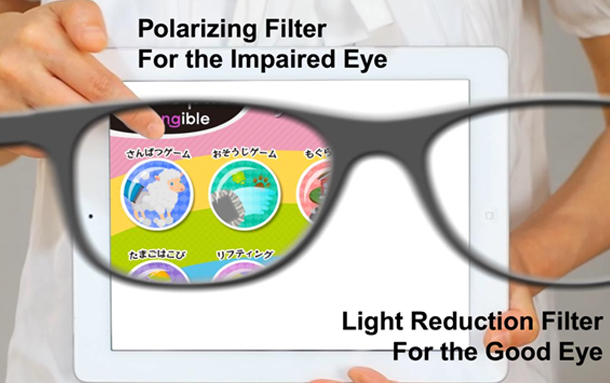March 2021 Issue
Topics
Innovative outlook for treating lazy eyes
Integrating polarized spectacles and smart tablets offers promising long term treatment for children’s amblyopia
Yo Ishigaki
Specially Appointed Associate Professor, UEC Tokyo
Amblyopia also known as “lazy eye” is an eye disorder that results in poor vision of one eye. It is prevalent in children and young adults with 3% of newborn babies affected across all races. The most common treatment is covering the healthy eye with a “patch” and thereby forcing the other affected one to work harder to improve neurological connections with the brain.
However, eye-patching can lead to both psychological stress and physical skin rashes. So it is challenging to encourage children to wear an eye-patch for the long periods of time that is required for effective treatment.
Occlu-pad system
In an innovative alternative approach to eye-patching, Yo Ishigaki and colleagues at the School of Medicine of Kitasato University in Sagamihara, Japan, have developed new technology consisting of a pair of spectacles with a polarizing filter as one lens; a light reduction filter for the other; and a touchscreen tablet that has had its polarizing film layer removed. The spectacles are designed so that the lens with the polarizing filter covers the impaired eye and the one with the light reduction filter covers the healthy one.

“With our “Occlu-pad” system, children wearing our special glasses are only be able to view images emanating from the iPad through the eye with the polarized lens in their glasses,” explains Yo Ishigaki. “The results of clinical trials carried our by doctors at Kitasato University showed that amblyopia training with our “Occlu-pad” system was significantly more effective than eye-patches for the treatment of this disorder.”
The important point is that this system includes entertaining games that children enjoy playing and thereby wear the spectacles continuously for periods of times that are much longer than eye-patches.
“We worked with globally renowned game making companies to design enjoyable games for children,” says Ishigaki. “Our system has a wide range of games and special glasses catering for children of all ages.”
Global outlook
Japan has 30,000 patients per year (p/y), which is significantly lower than the USA 118,00 p/y; EU 153,900 p/y; China 506,000 p/y; and India 830,000 p/y. Ishigaki is focusing on supporting treatment of amblyopia in India by working with healthcare institutes in cities including Ahmedabad, Jaipur, Delhi, Mumbai, and Kolkata.
“The main issue that we must resolve for the proliferation of this system in India is cost,” says Ishigaki. “The cost of an iPad is too high for most families in India. However, during my regular trips to visit collaborators in India I have realized that almost everyone has a smart phone. So I am working with colleagues in Japan to develop an Occlu-Smartphone system, which should be much more accessible to people in India and other parts of Asia.”
References
[1] Yo Iwata et al, Evaluation of the Effects of the Occlu-Pad for the Management of Anisometropic Amblyopia in Children, Curr Eye Res, 43(6):785-787 (2018). doi: 10.1080/02713683.2018.1439066. Epub 2018 Feb 16.


